- By Dan Veaner
- Around Town
 Print
Print 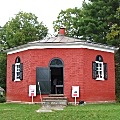 School is supposed to be out on Saturdays. But that didn't stop folks who came to have a look at the Eight Square School House on Saturday. The landmark one-room schoolhouse is celebrating its 200th year, and in some ways it is as vital a school as it was 200 years ago. Eight Square School House and Youth Education Director Carle West takes students back in time for a day in an 1892 school.
School is supposed to be out on Saturdays. But that didn't stop folks who came to have a look at the Eight Square School House on Saturday. The landmark one-room schoolhouse is celebrating its 200th year, and in some ways it is as vital a school as it was 200 years ago. Eight Square School House and Youth Education Director Carle West takes students back in time for a day in an 1892 school. "The kids become totally immersed in the 1890s time period," she says. "They dress for the day. They bring a period lunch. They have no computers. They have no cell phones, and they don't miss them. At the end of the day we ask them what they liked and didn't like about the day. Mostly we hear that they didn't like the outhouses. They love the well and pump. They pump their own water to wash their hands, and they like the pen and ink lesson. Most of the kids like all of it."
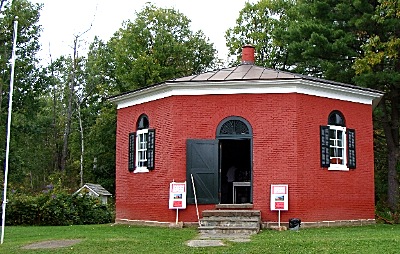
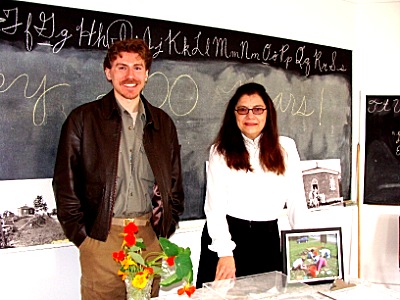 Archeologist Brant Venables and Tompkins County History Center Eight Square School House and Youth Education Director Carle West
Archeologist Brant Venables and Tompkins County History Center Eight Square School House and Youth Education Director Carle WestThe eight square school house is owned by the Tompkins County History Center. is part of 'Kids Discover the Trail' and the Ithaca Public Education Initiative. This summer a pilot archaeology program was begun on the site. Some of the objects that were found were on display Saturday. Archeologist Brant Venables was on hand to talk about the dig and some of the objects that have already been unearthed.
A four-sided school was built on this site in 1814, but in 1827 a Dryden citizens decided they wanted a more permanent structure. They built the new eight sided school house out of brick. Today it is the earliest Tompkins County school building still standing.
The school was officially closed in 1941. The History Center bought the structure from the Banker's Association of Dryden for $10. It was let for various purposes, including an antique store. A group of teachers decided in 1976 (the 200th U.S. anniversary) the building should be used to teach kids. They developed a program in which they taught in the schoolhouse for the day. The program was run by Cayuga Nature Center until 1990 when the History Center decided to run it. The first History Center program was conducted in 1992. West has been teaching the program for 12 of those years. A Rochester native, West is an anthropologist focusing on Native American studies who has worked at museums, and outreach programs.
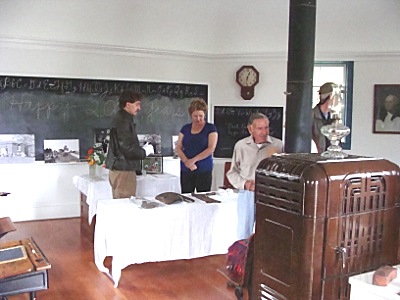
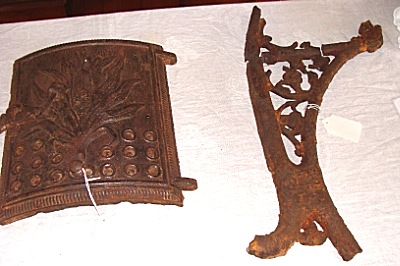 Artefacts from the archaeological dig were on display
Artefacts from the archaeological dig were on displayWest dresses in late 19th century clothing to teach the living history program that takes place in 1892. Seats and desks are fastened to the floor in two sections, one for boys and one for girls. One of the benefits of eight sides was that more windows could be placed. In the 1920s one window was covered up to facilitate the installation of a blackboard.
"We are very strict," she says. "We have complete control of the classroom. We teach the subjects that students would have been taught in the 1890s, which was a wide range of subjects. We also play games outside. Using old fashioned pen and ink is probably one of the more popular things we do."
Rows of students faced the windows, which provided the only light in the building, as well as cross ventilation. A wood stove in the center did not distribute heat well.
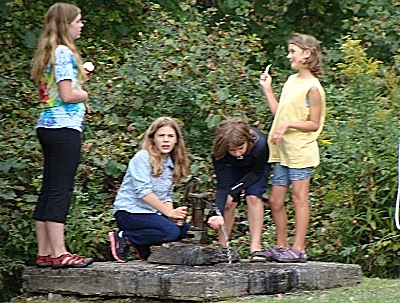
A period map from 1892 hangs on the wall, a Columbian pitcher pump outside the schoolhouse is used to get water. West says 1892 was the first year the 'Pledge of Allegiance' was recited in schools, and the first year that schools had American flags and conducted daily flag raising ceremonies.
"We were very specific in choosing 1892 because it was the 400th anniversary of Columbus coming to America," she says. "There was a huge patriotic push in the country beginning with the schools. The curriculums were redesigned that year to reflect the 400th anniversary, so many of the references we use in our class are to Columbus."
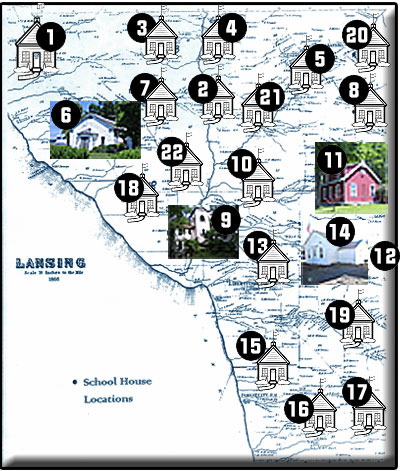 Over 100 individual school houses were in Tompkins County in the late 19th and early 20th centuries. Lansing alone had 22, some of which are still standing in various stages of disrepair today. They were the Lake Ridge School (1). the Fenner, later Brown, School (2), German School (3), French School (4) North Lansing School (5), Drake School (6), Lansingville School (7), Munson School (8), Ludlowville Union School (9), North, later Searles, School (10), East Lansing School, (11), a school about a mile west of East Lansing (12), South lansing School (13), Field School (14), Lake Road School (15), Gibbs School (16), Brown School (17), Bebe, also known as Haring, School (18), Head School (19), Mutton Hollow School (20), Early North Lansing/Genoa School (21), Lobdell or Emmons School (22). A 23rd, the Sage School, was added later. (Information provided by Lansing Historian Louise Bement)
Over 100 individual school houses were in Tompkins County in the late 19th and early 20th centuries. Lansing alone had 22, some of which are still standing in various stages of disrepair today. They were the Lake Ridge School (1). the Fenner, later Brown, School (2), German School (3), French School (4) North Lansing School (5), Drake School (6), Lansingville School (7), Munson School (8), Ludlowville Union School (9), North, later Searles, School (10), East Lansing School, (11), a school about a mile west of East Lansing (12), South lansing School (13), Field School (14), Lake Road School (15), Gibbs School (16), Brown School (17), Bebe, also known as Haring, School (18), Head School (19), Mutton Hollow School (20), Early North Lansing/Genoa School (21), Lobdell or Emmons School (22). A 23rd, the Sage School, was added later. (Information provided by Lansing Historian Louise Bement)The program targets 4th grade, though when home schooled students come they range from ages 6 to 16, which is closer to what one room schoolhouses were like at that time. To date Lansing, Ithaca, Trumansburg, and Montessori schools, home schools, and some schools from outside Tompkins County, including some from as far as eastern New York and Pennsylvania have taken part in programs at the school house. Adult groups also come. West says her goal is to eventually Involve all the school districts in Tompkins County. She is especially hopeful that Dryden classes will come, because it is within their school district. Next year West says she hopes to be able to offer a summer camp.
"It's definitely a unique design," West says. "This one is the only brick octagon school house in all of New York State. We want to use the building as much as we can."
v10i36


